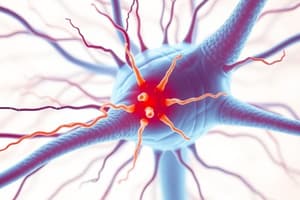Podcast
Questions and Answers
Which of the following sensory systems is consciously driven and refers to our special senses and somatic senses?
Which of the following sensory systems is consciously driven and refers to our special senses and somatic senses?
- Somatosensory system (correct)
- Nociceptors
- Thermoceptors
- Mechanoreceptors
Which of the following sensory systems is subconsciously driven and includes stimuli associated with our visceral organs?
Which of the following sensory systems is subconsciously driven and includes stimuli associated with our visceral organs?
- Nociceptors
- Somatosensory system (correct)
- Mechanoreceptors
- Thermoceptors
Which component of the somatosensory system detects mechanical stimuli?
Which component of the somatosensory system detects mechanical stimuli?
- Sensory receptors
- Nociceptors
- Mechanoreceptors (correct)
- Thermoceptors
Which component of the somatosensory system detects painful stimuli?
Which component of the somatosensory system detects painful stimuli?
Which component of the somatosensory system detects changes in temperature?
Which component of the somatosensory system detects changes in temperature?
Which receptors are found in the subcutaneous tissues of the hand and are responsible for discriminating fine surface textures?
Which receptors are found in the subcutaneous tissues of the hand and are responsible for discriminating fine surface textures?
What percentage of the cutaneous receptors of the hand do Pacinian corpuscles represent?
What percentage of the cutaneous receptors of the hand do Pacinian corpuscles represent?
Which receptors provide information about light and steady pressure, and act as slowly-adapting tonic receptors?
Which receptors provide information about light and steady pressure, and act as slowly-adapting tonic receptors?
Where are Ruffini's corpuscles located?
Where are Ruffini's corpuscles located?
What do receptive fields of somatosensory neurons provide insight into?
What do receptive fields of somatosensory neurons provide insight into?
Which receptors are responsible for sensing pain and temperature stimuli?
Which receptors are responsible for sensing pain and temperature stimuli?
What is the function of encapsulated receptor endings?
What is the function of encapsulated receptor endings?
What is the role of somatosensory afferent receptors?
What is the role of somatosensory afferent receptors?
What is the difference between slowly adapting and rapidly adapting receptors?
What is the difference between slowly adapting and rapidly adapting receptors?
Which mechanosensory receptor is specialized to respond to changes in texture?
Which mechanosensory receptor is specialized to respond to changes in texture?
Which type of receptors are primarily sensitive to temperatures lower than body temperature?
Which type of receptors are primarily sensitive to temperatures lower than body temperature?
Which type of receptors are primarily sensitive to temperatures between 37°C to 45°C?
Which type of receptors are primarily sensitive to temperatures between 37°C to 45°C?
What type of stimuli do nociceptors respond to?
What type of stimuli do nociceptors respond to?
What is the main difference between thermoreceptors and nociceptors in terms of their response to temperature changes?
What is the main difference between thermoreceptors and nociceptors in terms of their response to temperature changes?
Which type of pain perception is sharp and localized?
Which type of pain perception is sharp and localized?
Which pathway carries mechanosensory and proprioceptive information from the upper and lower body to the brain?
Which pathway carries mechanosensory and proprioceptive information from the upper and lower body to the brain?
Where do the sensory roots of the trigeminal nerve enter the brainstem?
Where do the sensory roots of the trigeminal nerve enter the brainstem?
Which region of the thalamus receives information from the trigeminal lemniscus pathway carrying pain/temperature and mechanosensory information from the face?
Which region of the thalamus receives information from the trigeminal lemniscus pathway carrying pain/temperature and mechanosensory information from the face?
Which cortical region is located in the post central gyrus of the parietal lobe and is responsible for processing tactile and proprioceptive stimuli?
Which cortical region is located in the post central gyrus of the parietal lobe and is responsible for processing tactile and proprioceptive stimuli?
What is the function of the higher cortical centers and association cortices in the somatosensory system?
What is the function of the higher cortical centers and association cortices in the somatosensory system?
Which pathway corresponds to noxious and thermal stimulation of the face?
Which pathway corresponds to noxious and thermal stimulation of the face?
Where do the sensory afferents synapse onto second order neurons in the spinothalamic system?
Where do the sensory afferents synapse onto second order neurons in the spinothalamic system?
Where do first order neurons carry sensory information from facial nociceptors and thermoceptors in the trigeminal pain and temperature system?
Where do first order neurons carry sensory information from facial nociceptors and thermoceptors in the trigeminal pain and temperature system?
Where do third order neurons within the ventral posterior medial nucleus send projections to for processing in the trigeminal pain and temperature system?
Where do third order neurons within the ventral posterior medial nucleus send projections to for processing in the trigeminal pain and temperature system?
Which region allows for affective and executive processing in the pathway that mediates the affective-motivational aspects of pain?
Which region allows for affective and executive processing in the pathway that mediates the affective-motivational aspects of pain?

